10 ideas for business speaking activities using visual communication
At the recent BESIG 2016 conference in Munich, John Hughes and Robert McLarty’s book ETpedia Business English received The David Riley Award for Innovation in Business English and ESP. The two authors also gave a talk at the conference to showcase some of the activities in the award-winning title. Their focus was visual communication in Business English.
In this blog, they bring you 10 ideas for business speaking activities using visual communication.
Visual communication is an everyday tool for presenting and selling business concepts, because images, shapes, charts and diagrams help to make sense out of potentially complex information or large quantities of data.
When you use visual communication techniques in your language lessons, they will seem familiar to your students and will help them to express themselves in English. They also have the advantage of allowing students to express ideas in English without having to cope with the barrier of text first.
Here is a collection of 10 ideas (taken from ETpedia Business English and other sources) which provide starting points for using visual communication to encourage speaking practice and communication skills.
1 Photographs
As language teachers we know that using photographs is a natural way to teach basic vocabulary by matching a word to a photograph.
We also use good photographs as a lead-in to lessons by asking the right kind of questions such as: What does the picture show? Why do you think this picture was taken? Imagine this picture is for an advertisement. What product or service would it advertise? What would the slogan be?
2 Works of art
Like photographs, paintings and works of art can act as a springboard to expression even for those students who don’t like it. You could take a selection of classical or modern paintings into class and ask students to state preferences and give their opinions.
One way to have an instant meeting is to ask students to imagine they are choosing artworks for the reception area and corridors of their company. They look at a selection of paintings and have to discuss which six of them would be best; for example, they can discuss which paintings reflect the values of the company or will appeal to visitors.
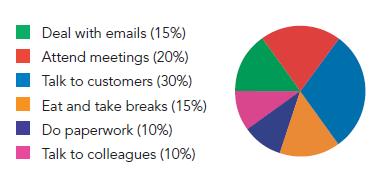 3 Pie charts
3 Pie charts
When you want students to talk about their routines or how they spend time, ask them to draw a pie chart before speaking and then present it to a partner. In the example below, the pie chart shows a proportion of a student’s working day and the student uses the present simple to describe what he/she does.
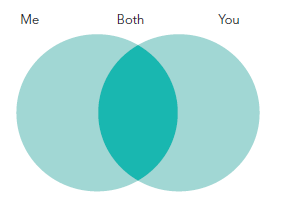 4 Venn diagrams
4 Venn diagrams
Venn diagrams are a good way for students to organize their thoughts when comparing two sets of ideas. This idea for using a Venn diagram came from Jon Wright's IATEFL 2016 talk.
Students work in pairs and make small talk to find out what is different about them and what they have in common. Draw the Venn diagram on the board and a list of topics to discuss such as ‘Jobs / Interests and hobbies / Travel / Plans for the future’. They have 5 minutes to make small talk about each topic and write notes in the diagram about what they each do and what they both do. It’s a great way to develop networking skills.
5 Squares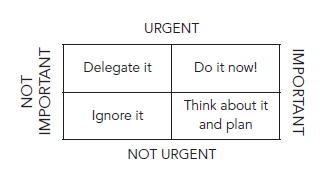
The two previous ideas both involve circles so here’s one using four squares called a ‘Priority Matrix’, based on an idea by business author Kevin Duncan.
Draw the matrix on the board and ask students (on their own) to list eight things that they currently have to do for work. They then work in pairs, describe each point on their list to a partner, and discuss where to put it on the priority matrix. For example, should they do a task now or can they ignore it?
 6 Flowcharts
6 Flowcharts
Those in business often use flowcharts to present different concepts, so it makes sense to apply them in the classroom. Either ask students to bring in flowcharts and you provide the language they need to present the different stages, or give the students a blank flowchart like this and ask them to fill in the squares with notes about a process they have to follow.
You can also turn this into an information gap activity where one student describes the process and the other student listens with a blank flowchart and fills it in based on what their partner says. This also helps you, as a teacher, understand what your students actually do in their working lives.
7 Mind maps
Mind maps are regularly used to generate new ideas in business or to solve problems in teams, so use them in your English lessons for brainstorming exercises. For example, if you were going to have a lesson on the topic of ‘Security’, you could start the lesson off by finding out what the language students know and writing it up on the board.
Teaching students to use mind maps to note topic vocabulary like this is also good for their independent study skills, helping them learn to record vocabulary in a useful way.
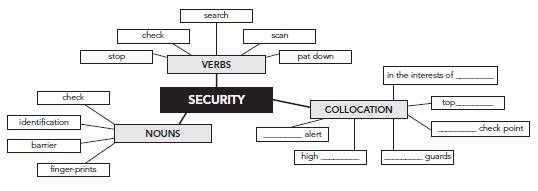
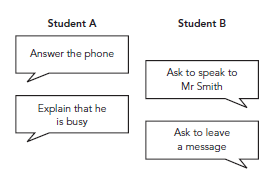 8 Frameworks
8 Frameworks
Speaking ‘frameworks’ are similar to flowcharts and you often see them used in class for controlled speaking practice. In the extract from the beginning of a framework below, pairs of students are given the prompts to practise a routine phone call. It’s easy to tailor your own frameworks so that you target the language that the student needs for his or her own job.
9 Graphs
Many teachers who work with business students will have taught language for describing graphs and charts. The classic activity is to put students in pairs with the same graph but two different trend lines. They take turns to describe their trend line and the other student draws it onto the graph.  However, there are other more personalized ways to use graphs. Using the ‘career graph’ below, students draw a line to express the highs and lows of their careers along the horizontal line which represents time.
However, there are other more personalized ways to use graphs. Using the ‘career graph’ below, students draw a line to express the highs and lows of their careers along the horizontal line which represents time.
It’s quite a personal task so use it with students who feel comfortable with each other or in a one-to-one lesson where you want the student to give you some background on their work history. After students have drawn the line, they present it and give reasons why there are peaks and troughs; eg. ‘Two years ago I wasn’t very happy in my job so I moved to a new company and things really improved because…’
10 Infographics
Infographics present information in a visual format with facts and figures. You will find infographics on many different business-related topics and they provide a quick and easy way to introduce a discussion point for a lesson. Two good sources are Daily Infographic (http://www.dailyinfographic.com/ and http://dailyinfographics.eu/).
Students can also create their own using free web tools such as Easelly, Piktochart, and Canva Infographic Maker.
Further reading and references
For more on how visual communication is used in business and with practical ideas which can easily be adapted for language teaching, read Kevin Duncan’s The Diagrams Book LID and Mark Edwards’s The Visual Communications Book (both by LID publishing).
For business speaking activities made for the classroom, see ETpedia Business English. You can also get 10 more ideas on using visual literacy in the classroom.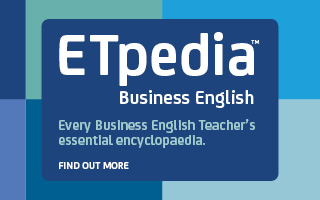
Comments
Write a Comment
Comment Submitted